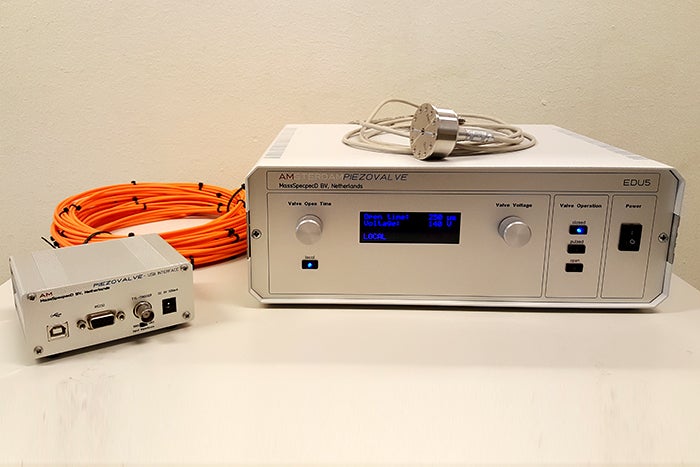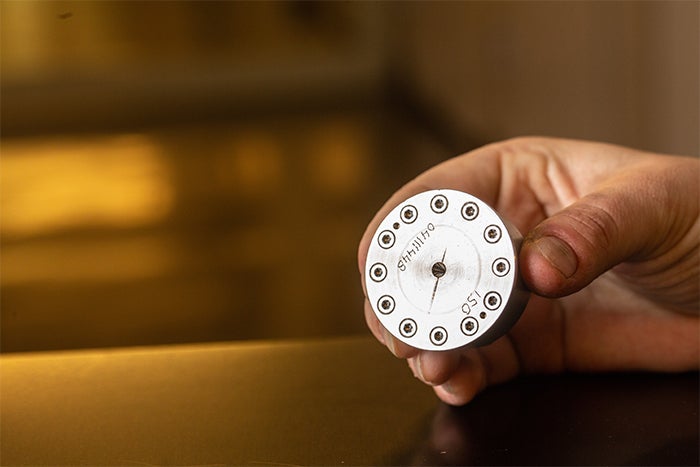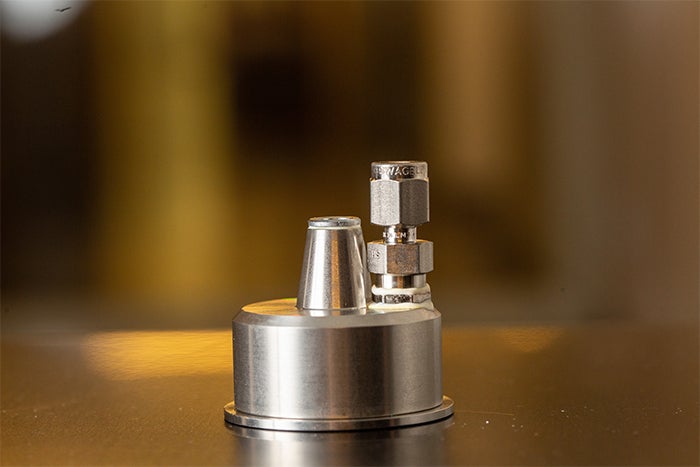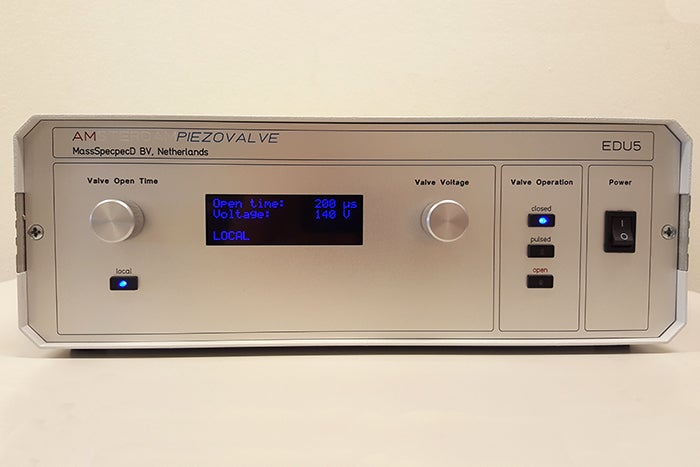Amsterdam Piezo Valve
Produces short and intense pulsed atomic and molecular beamsThe Amsterdam Piezo Valve (APV)
APV produces short (<20 microseconds) and intense pulsed atomic and molecular beams of wide interest for research in physics and chemistry. The APV can operate both in continuous and in pulsed mode (DC - 5 kHz). The short pulse duration makes the APV very suited for applications in combination with pulsed lasers. The APV consumes typically a factor of ten less sample relative to a conventional magnetically activated plunger valve, saving a lot of sample that is otherwise wasted. The low gas load makes the design of the vacuum apparatus much simpler, requiring smaller pumps and saving financial resources.
The APV system consists of a valve body with different nozzle shapes (ACPV2/ACPV3) and a matching Electronic Driver Unit (EDU5). The EDU5 is the latest generation electronic driver for operation of the APV offering great flexibility in computer control and accurate digital timing. The EDU5 can be operated locally, with front panel manual control, and remotely via USB computer control.
The Fiber Remote Control (FRC, optional) provides flexible computer control via USB/RS232/TTL and allows control of the APV over large distances (10, 30, 100 meter fibers). This enables researchers to locate the experimental apparatus with the APV system far away from the experimental control hub. By using fiber optics control we also create a galvanic isolation of the EDU5 and the ACPV valve body. This makes it possible to float the whole APV system up to 20 kilo-Volts relative to the earth potential for applications in charged particle (electron, ion) detectors. We provide a separate hardware enclosure (ISO-BOX) that safely houses the EDU5 and provides an isolation transformer for direct implementation of the ACPV and EDU5 in a galvanically floating setup.
Features
- Computer control of EDU5 via USB (distance up to a few meters)
- Optional Fiber Remote Control & trigger of EDU5 (FRC10/30/100)
- Isolated floating operation of the EDU5 with FRC and ISO-BOX
Specifications
· Repetition rate: DC to 5 kHz; by TTL trigger of EDU5
· Pulse duration: variable between about 20 microsec and multiple millisec, up to continuous
· Nozzle diameter: typically 150, 200 and 300 micrometer; other diameters on request
· ACPV2 conical exit with 40 degrees opening angle after nozzle
· ACPV3 nipple extension (2-5 mm) with straight channel opening (200-700 micrometer)
· Backing pressure: 0 to 15 Bar max; typically 0 - 5 Bar




Background
The Amsterdam Piezo Valve was first developed during 2007-2009 in the group of former Prof. Maurice Janssen in close collaboration with the Electronics and Mechanics engineering groups of the Faculty of Science at Vrije Universiteit Amsterdam. In 2009 the first commercial system was sold to Oxford University in the UK. Since those early days the APV has continuously been further developed and has been delivered to many academic groups and large scale research facilities worldwide. Since 2015 the startup company MassSpecpecD BV (founded by Maurice Janssen) exclusively markets, sells and provides support for the Amsterdam Piezo Valve. Behind the scenes, the engineers of the Electronics and Mechanics engineering groups of the Faculty of Science continue to produce and further develop the Amsterdam Piezo Valve.
The Amsterdam Piezo Valve has been purchased by many (> 50) research groups and institutes, amongst them: Fritz Haber Institute, Max Planck Gesellschaft Berlin, Germany DESY, CFEL and XFEL, Hamburg, Germany, SwissFEL and the Paul Scherrer Institute, Villingen, Switzerland , Argonne National Laboratories, USA, Korea Advanced Institute of Science and Technology, Korea, Rutherford Appleton Laboratory, United Kingdom, Beijing University, China, CNRS Bordeaux, France , Sandia National Laboratories, Livermore, USA, University of Tokyo, Japan , East China Normal University, Shanghai, China , University of California, Santa Barbara, USA , ETH, Zurich, Switzerland, University of British Columbia, Vancouver, Canada, IBM (Thomas J. Watson Research Center), USA
Read also the credential of Laura Dreissen
Publications
§ A short pulse (7 μs FWHM) and high repetition rate (dc-5kHz) cantilever piezovalve for pulsed atomic and molecular beams, Review of Scientific Instruments 80 (2009), 113303 (pdf link)
§ In situ characterization of a cold and short pulsed molecular beam by femtosecond ion imaging, Physical Chemistry Chemical Physics 11 (2009), 3958 (pdf link)
§ Measurement of the density profile of pure and seeded molecular beams by femtosecond ion imaging, Review of Scientific Instruments 86 (2015), 023110 (pdf link)
More information
Further detailed information, references and publications by customers of APV: www.amsterdampiezovalve.com
For all scientific, technical and commercial requests for further information contact:
Maurice H.M. Janssen E info@amsterdampiezovalve.com T +31611050769 , mauricehmjanssen (Skype/Google voice)
Only for applications within VU related research projects contact:
Rob Limburg, Electronic Engineering VU, E rob.limburg@vu.nl, T +31 20 59 87973
